
|
Special Effects (F/X) - Milestones in Film 1995-1996 |
| Film Title/Year and Description of Visual-Special Effects | ||||||||||||

|
Babe (1995, Australia)
It used a combination of real and animatronic animals: pigs and border collies. Many piglets (Large White Yorkshire purebreds) were required for the production since they grew so fast -- and were the right size for Babe for only a three week stretch. Pigs were filmed when they were between 16 and 18 weeks of age and 18 inches tall. Every three weeks, litters of pigs were bred for filming - and only female pigs were used -- to avoid displaying the prominent genitals of the males. There was one animatronic pig, used for wide-open shots (when there was 15-20 feet of open space in all directions around the pig), when a trainer couldn't be nearby. And the animatronic pig was also used for reverse, over-the shoulder POV shots, when Babe was talking to another animal. In post-production, special effects engineers overlaid innovative computer modeling over the live animals' jawlines. The lips of animals moved in sync with speech, digitally-modified in order to create human-like talking "mouths." In some cases, the animatronic pig was manipulated to mouth words. The finale was a sheepherding contest in which Babe successfully and flawlessly corraled a flock of sheep into a pen, and was praised by farmer Arthur Hoggett's (James Cromwell) words: "That'll do, Pig. That'll do." |
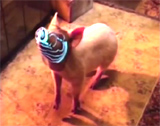 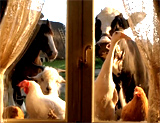 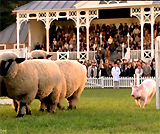 
|
||||||||||
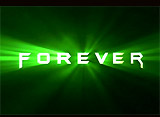
|
This comic-book film adaptation directed by Joel Schumacher was the third entry in a long-running series of superhero films. Bruce Wayne/Batman (Val Kilmer), accompanied by orphaned acrobat/sidekick Dick Grayson/Robin (Chris O'Donnell), faced off against two villains:
Most of the visual effects were a combination of computer technology (CGI), motion capture, stereopsis, green-screens, and miniature photography (miniatures were constructed of the Bat Cave - a 1/6th scale cave interior, the Batwing Plane exiting the Bat Cave, and the Arkham Asylum exterior). It also featured a very realistic, fully 3D CGI cityscape or skyline. Trains or vehicles ran on tracks or elevated highways between buildings high above the city. Digital, realistic 3-D stunt doubles (and even a stunt double for Batman) were used for intense action sequences. Optical motion capture was used to capture the movements of a gymnast, then transferred to the on-screen character. [Note: The same technique was becoming increasingly used in films, such as in Judge Dredd (1995).] |
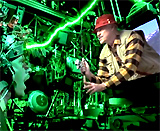 The Nygma Box - A Brain-Sucking Device 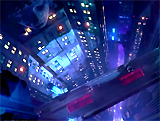 Gotham Cityscape 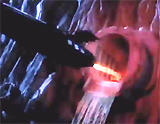 The Batwing Plane Exiting the Bat Cave |
||||||||||
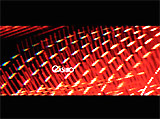
|
Casino (1995) Martin Scorsese's epic crime film was an examination of the gaudy, mob-controlled glittering city of Las Vegas. Its tagline: "You don't stay at the top forever" applied to the main mobster character and casino manager Sam 'Ace' Rothstein (Robert DeNiro), who was confronted by two opposing forces:
It was the first feature film to use special effects software (rendering) that seamlessly integrated a 1970s era Las Vegas strip night scene into present-day, on-location live action footage. It used radiosity lighting (a bounce-lighting effect) to realistically simulate the millions of neon lights on the marquee strips at the casinos. This was the first time radiosity algorithms were used to create imagery for a feature film. |
 Without Radiosity 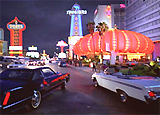 With Radiosity |
||||||||||
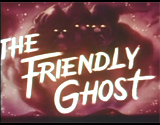 The Friendly Ghost (1945) 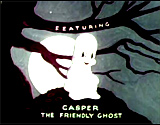 There's Good Boos To-Night (1948) - subtitle 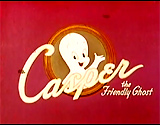 Harvey Films Title in the 1950s 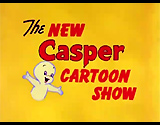 The New Casper Cartoon Show (1963- ) 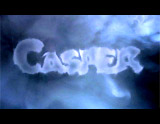
|
Casper (1995) The character of Casper first appeared in Paramount's Famous Studios 9-minute short film, the ‘Noveltoon’ production of The Friendly Ghost (1945). Casper also appeared in two other Noveltoon cartoons There's Good Boos To-Night (1948), and A Haunting We Will Go (1949). Casper then became a St. John Publications comic book character in late 1949. Harvey Comics purchased the rights to all the Casper products from Paramount Studios in the 1950s, and a series of Casper the Friendly Ghost cartoon animations from Harvey Films were made beginning with Casper's Spree Under the Sea (1950). Later, new cartoons were created for ABC's The New Casper Cartoon Show in 1963. The 1995 live-action full-length feature film, the first for Casper, was an expensive comedy updating, on a budget of $50 million (mostly for its special effects). Casper had a $16 million advertising and marketing campaign, and licensing tie-ins with more than 120 companies selling more than 1,000 Casper-related items. This was the first feature-length live-action film with a digitally-created, 3D CGI character that took a leading role (almost 40 minutes of film time). It had a record number of on-screen shots (over 350) with a digital character. The computer-generated, translucent image of the 'friendly spirit' Casper was the first fully-synthetic speaking character or performer with a natural and distinct personality expressing emotion. Many of the effects shots integrated the ghostly semi-transparent characters into live-action backgrounds. It was a 16 week production that required 15 months and 150 staffers at George Lucas' Industrial Light & Magic (ILM) to create the four ghost characters. They could only accomplish an average of five to eight shots a week. The story told about teenaged 13-year-old Kathleen 'Kat' Harvey (Christina Ricci) and her eccentric, paranormal "ghost therapist" and widower father Dr. James Harvey (Bill Pullman) who was hired to exorcise a haunted house named Whipstaff Manor in Friendship, Maine, inherited by greedy Carrigan Crittenden (Cathy Moriarty). The resident specters included four spirit creatures - all translucent ghosts that were entirely computer-generated images (CGI):
One of the more interesting aspects of the film was the Rube Goldberg-like contraption dubbed the Up-And-At-'Em Machine. It was essentially a chair-ride roller-coaster through a typical morning routine - face powdering, teeth brushing, face washing, shaving with cream and sharp straight-edged razors, face spraying, blow-drying and hair combing, and necktie-tying. In another sequence, the breakfast scene for Kat - Casper prepared and cooked breakfast (composed of CGI bacon, eggs, pancakes, and orange juice). |
  Casper with Kat 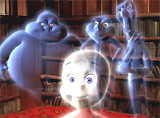 Casper and Three Uncles 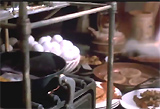 Digital Breakfast 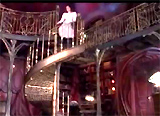 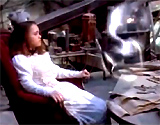 The Up-And-At-'Em Machine |
||||||||||
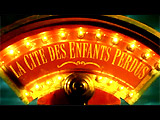
|
The City of Lost Children (1995, Fr.) (aka La Cité des Enfants Perdus) This surreal French film, by co-directors Marc Caro and Jean-Pierre Jeunet, reportedly had the greatest number of digital special effects, of the greatest length, ever made to date by a wholly French film crew. It was a dream fantasy science fiction tale about a dystopian world, in which a morose, bald-headed and mad scientist named Krank (Daniel Emilfork) lived in a laboratory located on a coastal oil rig surrounded by a minefield. He suffered from a lack of dreaming, and had grown prematurely old (and wanted to slow his aging), so he went about kidnapping innocent young children from their homes to extract and steal their dreams, often while wearing a Santa Claus outfit. The opening credits sequence, in which multiple Santas invaded a young boy's bedroom employed a special effect known as 'warping' to produce a nightmarish effect (causing the image to bend, warp, and distort) - it was also used in the film's final dream sequence. The kidnappings were performed by Krank's hired blind cultish group of 'Cyclops' (possessing a mechanical, video-camera third eye or Optacon, worn over their left eye, to provide vision) - their viewpoints were seen in greenish POV shots. Special effects shots were also used to multiply the image of Krank's six narcoleptic cloned assistants (Dominique Pinon) within a single shot or scene, and also used in the sequence of a flea (magnified in size) unleashed by an opium-addicted circus owner/organ-grinder to inject victims with a toxin that caused them to become violent. There were also some morphing sequences, changing individual's faces from old to young and vice-versa. The film's main story was about the kidnapping of a fearless blonde 5 year-old orphan or 'little brother' named Denree (Joseph Lucien) and the efforts of a silent, kind-hearted sideshow Strongman named One (Ron Perlman) and precocious 9 year-old Miette (Judith Vittet), the leader of an orphan band, to rescue the boy, by finding their way into Krank's laboratory. One of the film's most remarkable sequences was the Rube Goldberg-like chain of events of a teardrop, ultimately causing a freighter to crash into a pier. The sequence of events in the Teardrop Sequence follows:
|
 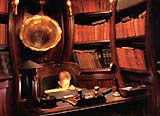 Warping 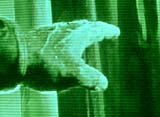 Optacon vision  Clones 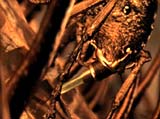 CGI-Flea 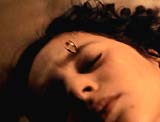 Start of Teardrop Sequence 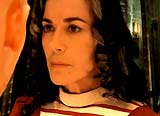  Morphing |
||||||||||
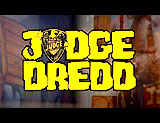
|
Judge Dredd (1995) Director Danny Cannon's futuristic sci-fi action film was based upon the fictional character in British comic books, first appearing in 1977 in the weekly sci-fi anthology 2000 A.D. Judge Joseph Dredd (Sylvester Stallone) was the main character - a perfect, fearless law machine "Street Judge" and enforcement officer in the dystopian, overcrowded, violence-ridden future city of Mega-City One in North America. The cityscape, similar to a medieval walled city (but in the future) was portrayed with elaborate realistic-looking miniatures, some large-scale, that were used as backgrounds to be composited with green-screen photography and filmed with computerized, motion-controlled cameras. There were also computer-generated buildings and vehicles. There were also two versions of the Lawmaster motorbikes: a road version and a flying version. One of the F/X laden sequences was Dredd's and recently-released convict Fergie's (Rob Schneider) flying Lawmaster motorcycle chase through the futuristic cityscape. It was created with a combination of digital images, green-screening, and the detailed miniature models and backgrounds - all carefully choreographed together. In some shots, digitally-created copies of the actors' faces were added to their computer-created stunt bodies. It was one of the very early examples of fully 3D digital stunt people. Another character was a large mechanically-controlled robot, an ABC Warrior combat robot named Hammerstein that appeared in a cameo role
|
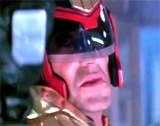 Judge Dredd (Sylvester Stallone) 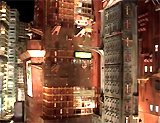 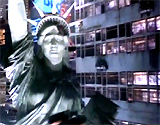 Mega-City One - An Elaborate Miniature Model  Green-Screening Behind Lawmaster Vehicle 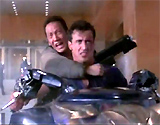 The Composited Image |
||||||||||
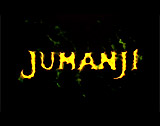
|
Jumanji (1995) Jumanji's tagline: "Roll the dice and unleash the excitement!" referred to an ancient magical, jungle-themed board game known as Jumanji. It had trapped inside itself a Man-Child named Alan Parris for 26 years (since 1969 when Alan was 12 years old), who was freed from the game's spell, when the game was replayed. This adventure-fantasy thriller used a combination of special effects (computer-generated graphics by ILM, and animatronics from Amalgamated Dynamics). When Judy and Peter Shepherd (Kirsten Dunst and Bradley Pierce) unsuspectingly began playing the game, they began unleashing a succession of creatures, many digital:
There was an amazing stampede scene with dozens of rhinos, elephants, zebras and pelicans (all computer-generated by ILM) during a rampage through a house and into town.
The special-effects company created the first computer-generated (CG), synthetic, photo-realistic hair and fur for the digital lion sequence and for the monkeys. There were other catastrophes or creatures, including bats, an earthquake, quicksand, spiders, a monsoon, and a giant alligator. |
 Giant Mosquito (Digital) 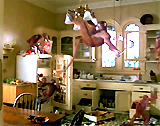 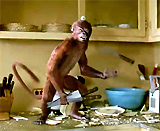 Evil Monkeys in Kitchen  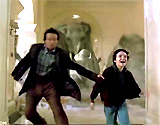 The Stampede of Exotic Digital Animals |
||||||||||
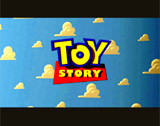
|
This was the first feature-length film made entirely by computer animation (CG), also fully 3-D, with a collaboration between Pixar (its debut film) and Disney Studios. Each frame took between 4 and 13 hours to complete. Before its release, computer graphics (CG) were mostly used for either short films or to supplement live action movies with special effects. In the mid-1990s, it was thought to be impractical to make an entire digital film with a computer. Now, computer-animated films have more or less become the new norm, and replaced traditional hand-drawn animated films. It was also a financial blockbuster, taking in $373.5 million at the box office (worldwide), and spawning major sequels, other spinoffs, and extensive merchandising. [Note: It was initially followed by equally-successful sequels Toy Story 2 (1999), and Toy Story 3 (2010), and other hugely popular Pixar/Disney animations.] |
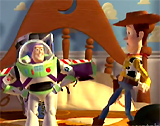 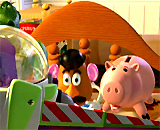 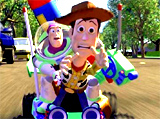
|
||||||||||
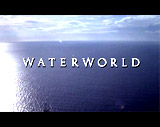
|
Waterworld (1995) Director Kevin Reynolds' apocalyptic sci-fi disaster-action film was noted as one of the most expensive films made to date - estimated at $172 million, due to cost overruns, production setbacks and weather difficulties. Actor Kevin Costner starred (as the gilled and web-footed mutant Mariner) and co-produced the film with Reynolds, in a story about the effects of global warming in the futuristic world of 2500. It was reminiscent of George Miller's Australian features: Mad Max (1979) and The Road Warrior (1982) (aka Mad Max 2 (1981, Australia)), and only received a Best Sound Mixing nomination for the Academy Awards. The main set was built off the coast of the Big Island of Hawaii - a floating, artificial island or atoll constructed of industrial waste. The main action sequences involved an attack on the island by the Smokers, oil-stealing raiders or pirates on jet skis, planes, and boats led by the one-eyed Deacon (Dennis Hopper). The film relied minimally on computer effects (and green-screening), because they weren't fully developed in the pre-digital Hollywood of the mid-1990s. However, it contained the first photo-realistic CG water effects, although it was unnecessary out on the actual ocean to use inferior CGI for some ocean background shots. Most of the water stunts with pyrotechnics and stunt doubles were practical and realistic effects, not digital. An amusement park ride was modeled after the film for Universal Studios in various parts of the globe. |
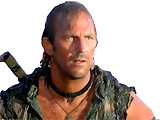 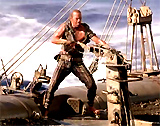  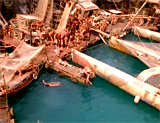 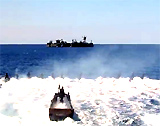 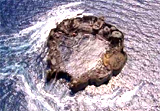
|
||||||||||
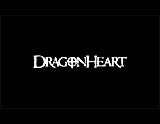
|
DragonHeart (1996) This 10th century fantasy fable, Oscar-nominated for Best Visual Effects, featured the first use of CARIcature software for the state-of-the-art digital animation seen in the film. It was used to create a very complex CG film character - a talking dragon named Draco, with lip-synched dialogue and a human-like personality. Draco also possessed realistic facial animation and expressions (eyebrow-raising, and lip-curling), and its voice was provided by Sean Connery. Draco was an 18 ft. tall, 43 foot long creature, with a wing span of 90 feet and was capable of blowing flames out of its nostrils. Draco helped knight Bowen (Dennis Quaid) to defeat an evil tyrant.
The dragon was expertly produced by Industrial Light and Magic (Phil Tippett and others) as a breakthrough 3D digital or CGI character, using CARI software that allowed animators to animate a fast-rendered version of the model, instead of animating to wire-frame models. [Note: See Mars Attacks! (1996) (below) which used the same process.] |
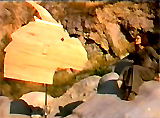 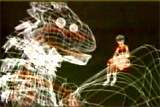  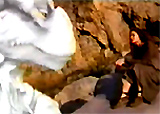 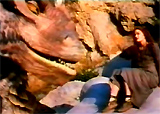
|
||||||||||
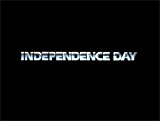
|
Independence Day (1996)
A remake, unofficially, of the original The War of the Worlds (1953), this world doomsday film displayed a monstrous, asteroid-sized UFO that entered Earth's atmosphere. $75 million was spent on models and miniatures (the film had more miniature model work than any other film up to its time), and there were over 3,000 visual effects shots in the film, including both in-camera effects and CGI post-production, motion-controlled photography, miniature models (for example, the spaceships and the White House), and real pyrotechnic explosives. The opening shots of the enormous, saucer-shaped City Destroyer (viewed above the surface of the Moon) as it was deployed from the Mothership with many other smaller spacecraft were all miniatures or models composited with other elements. The cloud formations of the ships entering the atmosphere were created in a cloud tank.
The most spectacular, well-publicized, and iconic scene was of the explosive destruction of the White House (a 1/12th model, about 14 feet wide, built out of plaster with a mold) by an alien spacecraft, filmed with 9 cameras. CGI work also included the depiction of F-18 Hornets, debris flying in the air, alien attackers, missiles, and light balls. |
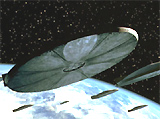 The Opening Scene  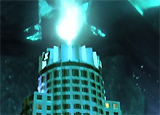 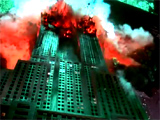 Destruction of Buildings in New York City |
||||||||||
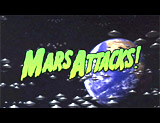
|
Mars Attacks! (1996) Tim Burton's zany science-fiction comedy was a parody of 50's era B movies (with the tagline: "Nice planet! We'll take it!"). It told about an alien invasion of saucers with Martians intent on taking over Earth. Although it was considered for an Academy Award nomination for Best Visual Effects, it was ultimately passed over. It used a combination of visual effects techniques, including CGI and practical effects (scale models or miniatures of London's Big Ben, the Washington Monument, the Taj Mahal, etc.). The highly-realistic aliens were all-digital, CGI animated creations, rather than stop-motion puppets. At first, the plan was to use stop-motion animation (paying homage to stop-motion animation legend Ray Harryhausen), but it became too expensive. The CGI-effects were produced with the same CARI software used in Dragonheart (1996), courtesy of Industrial Light & Magic (ILM). The CG aliens were composited (and integrated) into miniatures of the interiors of spaceships.
In addition, some of the more striking images were of chat show host Nathalie Lake's (Sarah Jessica Parker) head grafted onto the body of her pet Chihuahua Poppy, or of Lisa Marie as an emotionless, nitrogen gum-chewing Martian Girl spy inflitrating (or floating) into the White House. In the absurd ending, the Martians were defeated by hearing a recording of Slim Whitman's "Indian Love Call." |
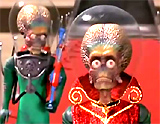 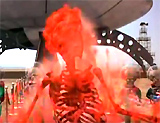 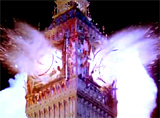 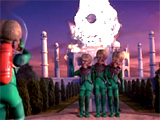 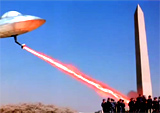 
|
||||||||||
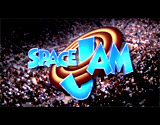
|
Space Jam (1996) This Warner Bros.' family adventure film combined traditionally-animated Looney Tunes characters (such as Daffy Duck and Bugs Bunny) within a live-action film. Its tagline was: "Get ready to Jam." It became the highest-grossing basketball sports film of all time, with $90.4 million (domestic) at the box-office. The film was inspired by a series of early 1990s Nike commercials featuring Bugs Bunny and Michael Jordan advertising Air Jordans.
In the film's plot, retired basketball star Michael Jordan was recruited by Bugs Bunny to help save the Looney Tunes from imprisonment in an amusement park known as Moron Mountain (a subtle jab at Disney theme parks, and a spoof of Magic Mountain), controlled by ruthless boss Swackhammer. A basketball game would determine their fate (freedom or enslavement):
When the Nerdlucks stole the talents of leading NBA basketball stars, they became massive basketball bruisers known as the Monstars, and the Tune Squad seemed doomed, until Michael Jordan decided to join the squad. In the stands, Looney Tunes characters were created for one section, and then replicated over and over as wallpaper - to create the illusion of a packed audience. [Note: The iconic characters would later star with Brendan Fraser in Looney Tunes: Back in Action (2003).] |
 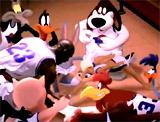 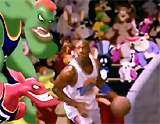 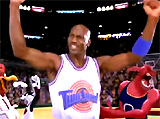
|
||||||||||

|
Twister (1996) Director Jan de Bont's blockbuster disaster film, with an enormous budget of $92 million, told about storm chasers and weather researchers who pursued deadly tornadoes. It became the second biggest film of the year, behind only Roland Emmerich's Independence Day (1996). Test footage from ILM of the twister (for a film without a script) was all it took for Warner Bros. to greenlight the film. It was being filmed at the same time as Casper (1995), and just before ILM's massive work on Star Wars: Episode 1 - The Phantom Menace (1999). Although nominated for the Academy Award for Best Visual Effects, along with Dragonheart (1996), both were defeated by Independence Day (1996). Some of the realities of what was depicted on screen were a little unrealistic in regards to the physical or scientific aspects of real tornadoes. For instance, large objects (a house, other vehicles, a cow, farm equipment, etc.) were blown around or in front of the stormchasers' truck, with little effect on their own vehicle. And tornadoes were seen spewing out debris, rather than sucking it in. The scene in which the two protagonists found themselves penetrating into the interior vortex of a twister - and releasing sensors - was pretty much science fiction.
There were, however, a phenomenal number of special-effects created for the film by ILM, using particle system animation software. There were dozens of "digital sky-replacement" shots, and incredible atmospheric FX (digital tornadoes and weather effects, such as the film's 200 foot tower of wind, simulated with jet engines). Many of the film's images were taken with hand-held cameras through windshields - capturing composited CGI animated tornadoes.
An amusement park attraction was built at Universal Studios Florida, named Twister...Ride It Out, from 1998 to 2015. |
 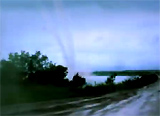 Hand-Held Shots Inside Vehicle - CGI Tornado Water Spouts 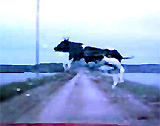 CGI Cow 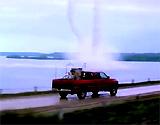 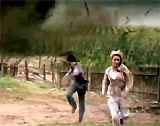
|
||||||||||